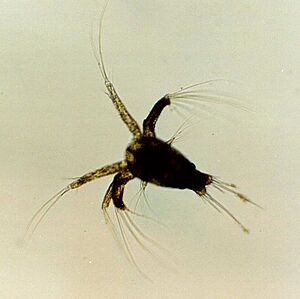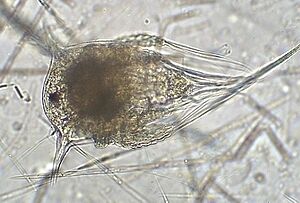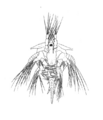Barnacle facts for kids
Quick facts for kids Barnacles |
|
|---|---|
 |
|
| Barnacles under water, showing the 'feet' in action | |
| Scientific classification | |
| Kingdom: | |
| Phylum: | |
| Subphylum: | |
| Class: | |
| Infraclass: |
Cirripedia
|
| Orders | |
|
|

A barnacle is a type of crustacean called a cirripede. Crustaceans are a group of animals that includes crabs and shrimp. Barnacles are covered with hard plates made of calcium carbonate, which is like a natural shell. They live stuck to hard surfaces in the ocean.
For a long time, people thought barnacles were a type of mollusc, like snails or clams. But in the 1830s, a scientist named J.V. Thompson discovered their tiny baby forms, called larvae. He watched them grow and found they had a special larva called a nauplius, which is common for crustaceans. Later, the famous scientist Charles Darwin spent eight years studying barnacles. He proved that Thompson was right!
Barnacles attach themselves to many hard surfaces. You can find them on piers, boats, rocks, and even on other animals like turtles and whales. They are different from crabs and shrimp, even though they are all crustaceans. Sometimes, barnacles can be a problem for boats because they stick to the hulls and slow them down.
Contents
How Barnacles Live
Barnacles are "suspension feeders." This means they eat tiny bits of food floating in the water. They use their special curved 'feet' to sweep food into their mouths. They are usually glued firmly to rocks and have hard, chalky plates that cover their bodies. When the tide goes out and they are out of water, they shut these plates tightly to stay safe and moist.
Barnacle Life Cycle and Reproduction
Barnacles reproduce sexually. They release tiny baby forms called nauplius larvae into the water. These larvae float around as part of the plankton. After a while, the larvae change into a different form called a cypris. This cypris larva then finds a hard surface to attach to. Once attached, it transforms into an adult barnacle.
Some types of barnacles have even become parasitic. This means they live on and get food from larger crustaceans. Barnacles are very common on rocky seashores. On one shore, scientists estimated there were a billion (1,000,000,000) barnacles! They also release a huge number of larvae each year, sometimes a trillion (1,000,000,000,000) of them.
Charles Darwin's Study of Barnacles
Charles Darwin, famous for his work on evolution, spent eight years studying barnacles in great detail. He wrote four important books about them. He divided barnacles into two main groups: those that grow on stalks (called pedunculated) and those that sit directly on surfaces (called sessile). He studied both living and fossil barnacles.
- 1851: A book about living stalked barnacles.
- 1851: A book about fossil stalked barnacles found in Great Britain.
- 1854: A book about living sessile barnacles.
- 1854: A book about fossil sessile barnacles found in Great Britain.
Images for kids
-
Whale barnacles attached to the throat of a humpback whale
-
Nauplius larva of Elminius modestus
-
"Cirripedia" from Ernst Haeckel's Kunstformen der Natur (1904): The crab at the centre is nursing the externa of the parasitic cirripede Sacculina.
-
Barnacles and limpets compete for space in the intertidal zone
-
Underside of large Chesaconcavus sp. (Miocene) showing internal plates in bioimmured smaller barnacles
-
Balanus improvisus, one of the many barnacle taxa described by Charles Darwin
-
Miocene (Messinian) Megabalanus, smothered by sand and fossilised
-
Barnacles attached to pilings along the Siuslaw River in Oregon
-
Goose barnacles in a restaurant in Madrid
See also
In Spanish: Cirrípedos para niños















